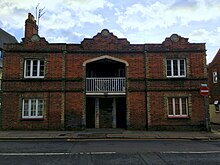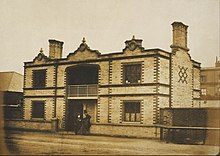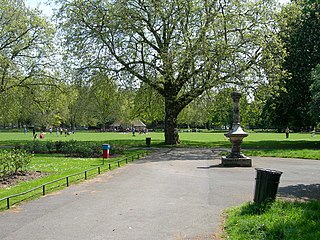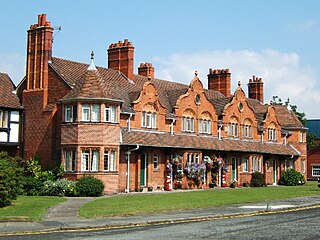
Prince Albert's Model Cottage was the name given to a model dwelling designed in the mid-19th century to offer an alternative form of accommodation for poor families in England. It was supported by Prince Albert, husband of Queen Victoria.

Prince Albert's Model Cottage was the name given to a model dwelling designed in the mid-19th century to offer an alternative form of accommodation for poor families in England. It was supported by Prince Albert, husband of Queen Victoria.

The original Prince Albert's Model Cottage, also known as the Prince Consort Model Lodge, was built by the Society for Improving the Conditions of the Labouring Classes (SICLC) for display at the 1851 Great Exhibition in Hyde Park, London. Prince Albert, who had considerable interest in improved housing for the poor, was president of the Society. [1] The Society wanted to have the model dwelling built on the Exhibition grounds, but the Exhibition commissioners were unwilling to have an exhibit that addressed such social issues. With the intervention of Prince Albert it was agreed that the building could be constructed close to, but not on, the Exhibition grounds, and this was done at the Knightsbridge Cavalry Barracks. At the conclusion of the Great Exhibition the cottage was dismantled and rebuilt in Kennington. [2] By one estimate over 250,000 people visited the cottage, including Queen Victoria and Charles Dickens. The final room visited contained pamphlets and books on model dwellings, as well as the architectural plans for the building through which the visitor had just walked, together with plans of other model dwellings built elsewhere by the society. [2]

The model cottage was designed by Henry Roberts, who was honorary architect to the SICLC, and, like the Prince Consort, was interested in upgrading housing for the working class. The cottage demonstrated at the Great Exhibition was possibly conceived as a model for larger blocks of flats (designs for a three-storey version were prepared). [3] It was designed to house four families, with two flats, or apartments, on each level. Roberts indicated that the design was aimed at “the class of mechanical and manufacturing operatives who usually reside in towns or in their immediate vicinity”. [1] Each flat had a living room, with a built-in cupboard heated by the fireplace that was also "well contrived equally to cook the family meals at midday and to warm the feet of the family group at eve", [4] a kitchen/scullery, three bedrooms and a toilet. Bathrooms were not usually provided in houses built in England at this time. Three bedrooms were included for the sake of "decency" [5] so that children of different sex would not have to share a room. [6] The most notable external feature was the covered central staircase to give access to the two upper flats. Hollow bricks were used for construction of the building. These were claimed to be sound resistant, damp resistant, non-porous, and cheap to make. The internal face of the walls was smooth and plastering was considered unnecessary. [2] [7]

Although built outside the main Great Exhibition area, the Prince Albert cottage exhibit was awarded one of the 170 Council Medals, the Exhibition's highest award. [2] [8] The design provided a catalyst for further work on model buildings and Roberts and the Society circulated several publications on the topic, including “The Dwellings of the Labouring Classes”. [9]
In 1852 the cottage was rebuilt in Kennington Park, south of the River Thames, and housed two park attendants and a cottage museum. Subsequently, it was occupied by the park superintendent and since 2003 has been the headquarters of the Trees for Cities charity. The design was used in several other locations, including Stepney and Kensington in London and Abbots Langley and Hertford, both in Hertfordshire. However, despite benefiting from the abolition of Britain's brick tax in 1850, [4] and while a success with the public, the cottages were not a commercial success, although the Spectator had calculated that a return on capital of between five and seven percent per annum would be possible. [4] The innovative use of hollow bricks was also never widely copied. [7]

Osborne House is a former royal residence in East Cowes, Isle of Wight, United Kingdom. The house was built between 1845 and 1851 for Queen Victoria and Prince Albert as a summer home and rural retreat. Albert designed the house himself, in the style of an Italian Renaissance palazzo. The builder was Thomas Cubitt, the London architect and builder whose company built the main facade of Buckingham Palace for the royal couple in 1847. An earlier smaller house on the Osborne site was demolished to make way for the new and far larger house, though the original entrance portico survives as the main gateway to the walled garden.

Prince Albert of Saxe-Coburg and Gotha was the husband of Queen Victoria. As such, he was consort of the British monarch from their marriage on 10 February 1840 until his death in 1861.

Kennington is a district in south London, England. It is mainly within the London Borough of Lambeth, running along the boundary with the London Borough of Southwark, a boundary which can be discerned from the early medieval period between the Lambeth and St George's parishes of those boroughs respectively. It is located 1.4 miles (2.3 km) south of Charing Cross in Inner London and is identified as a local centre in the London Plan. It was a royal manor in the parish of St Mary, Lambeth in the county of Surrey and was the administrative centre of the parish from 1853. Proximity to central London was key to the development of the area as a residential suburb and it was incorporated into the metropolitan area of London in 1855.

The Great Exhibition of the Works of Industry of All Nations, also known as the Great Exhibition or the Crystal Palace Exhibition, was an international exhibition that took place in Hyde Park, London, from 1 May to 15 October 1851. It was the first in a series of World's Fairs, exhibitions of culture and industry that became popular in the 19th century. The event was organised by Henry Cole and Prince Albert, husband of Victoria, Queen of the United Kingdom.

The International Exhibition of 1862, or the Great London Exposition, was a world's fair held from 1 May to 1 November 1862, beside the gardens of the Royal Horticultural Society, South Kensington, London, England, on a site that now houses museums including the Natural History Museum and the Science Museum.

An apartment, flat, or unit is a self-contained housing unit that occupies part of a building, generally on a single storey. There are many names for these overall buildings. The housing tenure of apartments also varies considerably, from large-scale public housing, to owner occupancy within what is legally a condominium, to tenants renting from a private landlord.
A semi-detached house is a single family duplex dwelling house that shares one common wall with the next house. The name distinguishes this style of house from detached houses, with no shared walls, and terraced houses, with a shared wall on both sides. Often, semi-detached houses are built in pairs in which each house's layout is a mirror image of the other's.

Frogmore is an estate within the Home Park, adjoining Windsor Castle, in Berkshire, England. It comprises 33 acres (130,000 m2), of primarily private gardens managed by the Crown Estate. It is the location of Frogmore House, a royal retreat, and Frogmore Cottage. The name derives from the preponderance of frogs which have always lived in this low-lying and marshy area near the River Thames. This area is part of the local flood plain. Its large landscaped gardens are Grade I listed on the Register of Historic Parks and Gardens.


Port Sunlight is a model village in the Metropolitan Borough of Wirral, Merseyside, England. It is located between Lower Bebington and New Ferry, on the Wirral Peninsula. Port Sunlight was built by Lever Brothers to accommodate workers in its soap factory ; work commenced in 1888. The name is derived from Lever Brothers' most popular brand of cleaning agent, Sunlight.

East Melbourne is an inner-city suburb in Melbourne, Victoria, Australia, 2 km (1.2 mi) east of Melbourne's Central Business District, located within the City of Melbourne local government area. East Melbourne recorded a population of 4,896 at the 2021 census.

The colony houses of Edinburgh were built between 1850 and 1910 as homes for artisans and skilled working-class families by philanthropic model dwellings companies. The first development was the Pilrig Model Buildings, near Leith Walk. Later developments across the city were built by the Edinburgh Cooperative Building Company Limited, founded in 1861. The founders of this company were influenced by the Reverend Dr. James Begg and the Reverend Dr. Thomas Chalmers, ministers of the Free Church of Scotland, who campaigned to improve the housing conditions of the poor.
Model dwellings companies (MDCs) were a group of private companies in Victorian Britain that sought to improve the housing conditions of the working classes by building new homes for them, at the same time receiving a competitive rate of return on any investment. The principle of philanthropic intention with capitalist return was given the label "five per cent philanthropy".
The Labourer's Friend Society was a society founded by Lord Shaftesbury in the United Kingdom in 1830 for the improvement of working class conditions. This included the promotion of allotment of land to labourers for "cottage husbandry" that later became the allotment movement, which the Society campaigned for after the Swing riots of 1830 as "the most plausible remedy for the social problems of the countryside". It published the Labourer's Friend Magazine, and in 1844 changed its title to the Society for Improving the Condition of the Labouring Classes, becoming the first Model Dwellings Company in 1844.
In London, the Metropolitan Association for Improving the Dwellings of the Industrious Classes (MAIDIC) was a Victorian-era, philanthropically-motivated model dwellings company. The association, established in 1841, was fore-runner of the modern housing association which sought to provide affordable housing for the working classes on a privately run basis, with a financial return for investors. Although not the first society to build such homes, the Association was the first to be founded expressly for this purpose. As such it was one of the earliest adopters of the principal of the five per cent philanthropy model, outlined in the Company's resolution: "that an association be formed for the purpose of providing the labouring man with an increase of the comforts and conveniences of life, with full return to the capitalist."

Romford Garden Suburb, is a late-Edwardian housing development in Gidea Park, in the London Borough of Havering. The object of the new suburb, which was built on land belonging to Gidea Hall, then occupied by the Liberal politician Herbert Raphael, was, according to his parliamentary colleague John Burns, to "provide families with a well-built, modern home regardless of class or status" and "to bring the towns into the country and the country into the towns".

Public housing in the United Kingdom, also known as council housing or social housing, provided the majority of rented accommodation until 2011 when the number of households in private rental housing surpassed the number in social housing. Dwellings built for public or social housing use are built by or for local authorities and known as council houses. Since the 1980s non-profit housing associations became more important and subsequently the term "social housing" became widely used, as technically council housing only refers to housing owned by a local authority, though the terms are largely used interchangeably.
